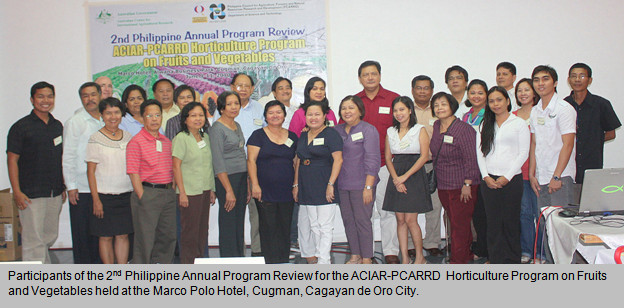Cagayan de Oro City – The production fruits and vegetables in the country is set to receive a boost from the Philippine and Australian Horticulture Program on Fruits and Vegetables. At the 2nd Philippine Annual Program Review of this Australian Centre for International Agricultural Research (ACIAR)- and PCARRD-funded program, participants presented the progress of their respective projects. Thus, identifying milestones and significant breakthroughs that served as the bases for laying out future directions and developing plans of work.

The programs in review
Under the vegetable program being implemented in Leyte, farmers have been trained on soil test and analysis so they could determine the proper amount of nutrients needed by various vegetables.
To support vegetable production in the area, researchers developed protected structures made from locally available materials like bamboo and coco lumber. Initial results showed that selected vegetables perform better under the protected cropping system. Local government units (LGUs) assisted in selecting the farmer-cooperators.
Still under the vegetables program in Regions X and XI, isolates of Ralstonia solanacearum affecting solanaceous crops were characterized. As part of the supply chain improvement, farmer clusters were organized to facilitate technology dissemination and explore market opportunities.
 Under the fruits program on the other hand, three supply chains of solo papaya, including markets from South Cotabato, Davao, and Manila, were mapped. Also, partners identified major pests and diseases of papaya, as well as the natural enemies of these pests.
Under the fruits program on the other hand, three supply chains of solo papaya, including markets from South Cotabato, Davao, and Manila, were mapped. Also, partners identified major pests and diseases of papaya, as well as the natural enemies of these pests.
Initial results are in from the Participatory Action Research trials on farm management strategies for Phytophthora disease in jackfruit and durian in Leyte and Davao areas. This early, an integrated approach to the management of the disease is showing promise. Component strategies that may be integrated include pruning, construction of drainage canals, use of elevated benches for seedlings, mounding, use of potting mixes, application of organic amendments, as well as employment of chemical control.
The focus in Southern Mindanao is on cecid fly, thrips and pulp weevil infesting mango. Incidence of pulp weevil in the field can be minimized with the use of attractants developed in the project and the practice of center canopy pruning.
On the other hand, stem-end rot and anthracnose diseases could be managed through the integrated cultural management strategy employed in organized mango farm clusters in the region. The effect of nutrition on disease incidence in mango is also being studied.
As part of the chemical residue analysis, pesticides with potential food safety issues have been identified. As a result, the protocol for supervised residue trials has been established.
Techno demos and farmer field days, through the Davao del Norte and Davao del Sur LGUs, are being conducted regularly to disseminate the mango technologies developed by the project. Also, the impacts of technologies are being assessed for their policy implications.
Thirty participants from the different collaborating agencies such as the University of the Philippines (UP) Los Baños; UP in Mindanao; Visayas State University (VSU); the Department of Agriculture’s (DA) Bureau of Plant Industry–Davao National Crops Research Development Center, Regional Field Unit X, and Northern Mindanao Integrated Agriculture Research Center; and Del Monte Philippines, Inc. participated in the review on June 9─11.
The program review was conducted in preparation for the upcoming program annual meeting and mid-term review slated on August 11─13 in Ormoc City.
